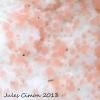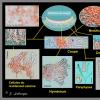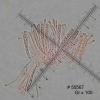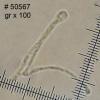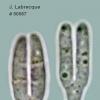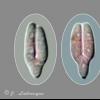
24-12-2025 17:08
Hulda Caroline HolteHello, I have found this propoloid ascomycete on

21-12-2025 09:32
Hello.A tiny ascomycete found embedded in wood in

21-12-2025 21:32
Pol DebaenstHello, Garden, Burgweg 19, Veurne, BelgiumOn 10/1

22-12-2025 23:38
Patrice TANCHAUDBonsoir, récolte sur un mur en pierre, apothéci

22-12-2025 00:47
Patrice TANCHAUDBonsoir, récolte à proximité du milieu dunaire
Bonjour !
Voici un Orbilia probable qui pousse sur la chair de vieux polypores du bouleau.
Orbilia se veut une tentative de genre uniquement.
Les spores sont peut-être immatures, ayant été photographiées et mesurées dans les asques.
Merci de nous aider, amitiés !
Roland
Données :
Ascome 0,2-0,6 mm de diam., sessile, rose à rose olivâtre, relié au substrat sur environ les 2/3 de la face externe inférieure
Substrat : contexte de vieux Piptoporus betulinus au sol
Asques cylindriques, souvent anguleux-sinueux à la base, graduellement élargis et aplatis vers l'apex, à 8 spores unisériées, inamyloïdes, 30-39 x 2,5-3,5 µm
Paraphyses étroitement cylindriques, ramifiées à la base, légèrement élargies-recourbées à l'apex ou capitées, septées, à contenu huileux à plus de 80%, parfois finement guttulé, 3-40 x 1,2-2,8 µm de diam., dépassant les asques de 2-3 µm
Sous-hyménium formé d'hyphes septées entremêlées.
Crochets absents
Spores ellipsoïdes, parfois légèrement plus allongées à une extrémité, avec une petite guttule difficile à préciser, 2,8-4 x 1,5-2 µm
Medulla en textura epidermoidea, formée de cellules polymorphes emmêlées
Revêtement externe formé de cellules piriformes à globuleuses, à paroi mince à légèrement épaissie, 5-10 x 5-8 µm
Marge formée de cellules cylindriques en palissade, 0,8-1,5 µm de diam.

probably Orbilia eucalypti (= coccinella s. auct., = O. alnea). It could perhaps instead be O. inaequalis (anamorph Dicranidion inaequalis). To be sure one would need some conidia of the anamorph, which are sometimes found around the apothecia.
Zotto

Dicranidion has septate conidia looking like a tuning fork.
Zotto

These are the conidia of Orbilia eucalypti (?)= O. alnea.
If you don't mind we will take up your record in our monograph. Then we would need the collection data includin herbarium number.
Zotto
Thank you Zotto !
Would you tell me what is the relationship between the name eucalypti and the fact that this species grows on Piptoporus betulinus, more in Québec ?
Amitiés !
Roland
Zotto,
Yes you can take our record.
Il will give you all the data you need.
Merci !
Roland

The anamorph is Dicranidion fragile. Strange enough this anamorph species was also described by Harkness from California, but in 1885 and on Nerium oleander, while O. eucalypti in 1884. But he did not see a connection between both, obviously. This was first documented by Brefeld 1891, though under a different O. coccinella, anamorph unnamed).
Zotto
